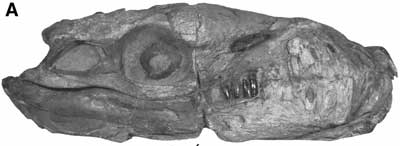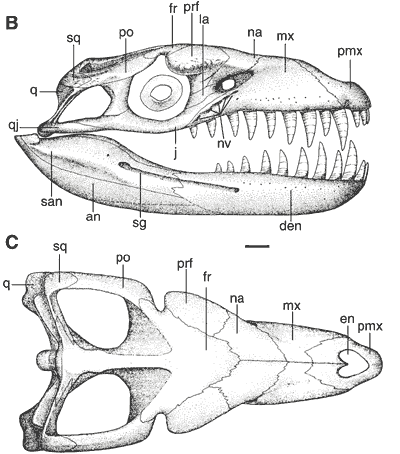PZ Myers. 2006 Jan 08. You call that a crocodile?. <http://pharyngula.org/index/weblog/you_call_that_a_crocodile/>. Accessed 2006 Feb 13.
Posted on M00o93H7pQ09L8X1t49cHY01Z5j4TT91fGfr on Sunday, January 08, 2006
You call that a crocodile?
Here's a cool beast from the late Jurassic/early Cretaceous that tells us a little more about the past diversity of crocodilians. It's called Dakosaurus andiniensis, and all we have of it is a skull and a few fragmentary post-cranial bits. It's a strange, strange skull, though.


D. andiniensis MOZ 6146P in (A) right lateral view. Skull reconstruction in lateral (B) and dorsal (C) views (based on left and right sides). Scale bars, 5 cm. Abbreviations: an, angular; den, dentary; dt, dentary tooth; en, external nares; eoc, exoccipital; fr, frontal; ic, internal carotid foramen; la, lacrimal; mt, maxillary tooth; mx, maxilla; na, nasal; nv, neurovascular foramina; pmx, premaxilla; po, postorbital; prf, prefrontal; pt, pterygoid; q, quadrate; qj, quadratojugal; san, surangular; sg, surangular groove; soc, supraoccipital; sq, squamosal.
When we think of a crocodilian, we picture either a flat, broad skull with many conical teeth, or if you're more familiar with reptilian exotica, something like the gharial, with a long narrow snout and numerous sharp teeth. These are adaptations for rapid side-to-side flicks of the head in the water, and for snagging prey.

Phylogenetic relationships of Crocodyliformes obtained in the cladistic analysis, plotted against geochronologic epochs (strict consensus of most parsimonious trees; some taxa distantly related to D. andiniensis collapsed into triangular clades). Only skull figures of Thalattosuchia were drawn to the same scale. Numbered nodes: 1, Crocodyliformes; 2, Neosuchia; 3, Thalattosuchia; and 4, Metriorhynchidae.
Dakosaurus is different: it has a relatively short, deep skull, with relatively few teeth that are sharp-edged and serrated. It's a most non-crocodilian skull, as far as the overall morphology goes, but the details tie it quite clearly to a specific lineage of ancient crocodilians.
It belongs to the Thalattosuchia, specifically the Metriorhynchids, which were marine crocodiles. They lacked the armored plates of modern crocs, lived in the ocean, and the caudal skeletons of the lineage show an interesting downward kink in their tails—they probably had vertical flukes, like the mosasaurs. The species most closely related to Dakosaurus also had elongated skulls with swarms of small sharp pointy teeth, and like the gharial, were almost certainly great fisheaters.
Dakosaurus, though, was different. It's another marine crocodile, and it's body may have been similarly adapted to an aquatic life (although we lack direct skeletal evidence for that), instead of hooking prey by slashing through schools of fish and squid, this sea monster had a deeply muscled skull for a strong bite, and a mouthful of long daggers good for slashing. What did it eat? We don't know—we need more fossils—but it does point to some diversity we've long since lost, and suggests that those Cretaceous seas were savage places.
Gasparini Z, Pol D, Spalletti LA (2006) An Unusual Marine Crocodyliform from the Jurassic-Cretaceous Boundary of Patagonia. Science 311(5757):70-73.
Science • Organisms • 0 Trackbacks • Other weblogs • Permalink
-
"...probably had vertical flukes, like the mosasaurs."
Did mosasaurs really posess tails like this? I thought they had laterally flattened paddle-like tails, and it was the Ichthyosaurs that had the flukes. Or have I missed some new discovery about mosasaurs?#: Posted by on 01/08 at 05:34 PM -
Yeah, Memo's right - AFAIK, mosasaurids had broad top-to-bottom tails, perhaps with increased surface areas to increase the paddle-shape, but not actual vertical flukes like sharks and ichthyosaurids..
#: Posted by on 01/08 at 05:44 PM
-
Yes -- that should be ichthyosaurid-like. The tails show that same distinctive ventral kink.
#: Posted by PZ Myers on 01/08 at 06:15 PM
-
There was an article about this Dakosaurus on National Geographic's pages some time ago. The article mentioned that the creature had some "fins" od "paddle-like limbs" instead of normal legs. However, at the same time, it said (like this article) that only the skull had been found. Does anybody know, where the information on the Dakosaur's limbs came from?
#: Posted by on 01/09 at 08:13 AM
-
From the phylogeny -- we have better fossils of some of its close cousins.
#: Posted by PZ Myers on 01/09 at 08:28 AM
-
I recently saw a piece on the National Geographic Channel about Sarcosuchous. This animal was thought to be able to ambush fairly large dinosaurs in a manner similar to the way crocs ambush animals coming to drink at rivers.
It was huge. How does Dakosaurus compare in size?#: Posted by on 01/09 at 12:19 PM -
That skull is 80 cm (about 30 inches) long.
#: Posted by PZ Myers on 01/09 at 12:27 PM
-
Hey, isn't that the crocodillian they are calling Godzilla?
#: Posted by Steve on 01/09 at 01:14 PM
-
The adaptive radiation of the crocodylians was truly amazing in its heyday. Now we only know representatives of the most "basic" body form, the amphibious ambush predators, because those that were more specialized had a harder time adapting to change. But back in the day, in addition to the pure ocean-dwellers and supergiant dinosaur-eaters described above, the world also boasted crocs that were slim bipedal runners (Gracilisuchus) and others that were adapted to chasing down prey on land or even in trees and probably lacked the ability to swim at all (Mekosuchus, Quinkana). One taxa from China was even a vegetarian! The land-and-tree crocs actually survived into historic times and was exterminated by humans.
#: Posted by on 01/09 at 03:01 PM
-
Sounds like the teeth was something like a shark's teeth (Great White). This would enable it to pray on animals that are larger is size and does not have to be swallowed whole, since the teeth would allow it to "cut" out bite size chunks on a larger animal?
#: Posted by on 01/11 at 05:34 AM